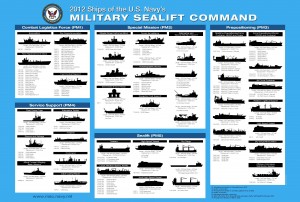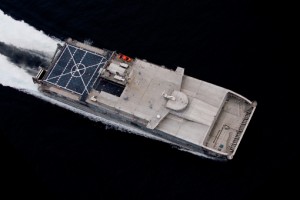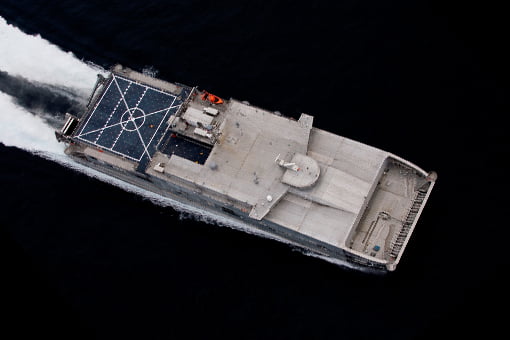2012-08-23 In a wide-ranging interview with Christopher Thayer, Director, Contractor Operated Ships, Military Sealift Command, the role of his Directorate in the re-structured MSC was discussed as well as a new asset coming into the MSC fleet, the Joint High Speed Vessel.
Mr. Thayer was appointed as the Director, Contractor Operated Ships at the Military Sealift Command (MSC) in January 2012. In this capacity he is responsible for overall strategic program planning, life cycle planning, force structure analysis, acquisition, POM/budget development, and resource allocations for the operation of more than 70 ships in the MSC fleet.
SLD: MSC has approximately 130 ships in the fleet. Of that amount, how many come under your purview as Director of Contractor Operated Ships?
Thayer: About 80 of those ships are under this Directorate. If you look at the basic MSC fleet chart, it would be the right side of the chart, or Special Mission (PM2), Sealift (PM5) and Prepositioning Ships (PM3). Every ship in the MSC fleet that does not have civil service government mariners operating the ship is in the contractor operated ship fleet.

The 80 ships would include ships that we take on for short periods of time for voyage charters or short-time charters to support the various programs.
SLD: How does the contractor operated ships business model work? Is it built around the nature of the personnel or the nature of the ship?
Thayer: In January of this year, Admiral Buzby restructured our business lines.
We now operate around two business lines or business modes.
The first is built around government operated ships and, in all cases, they are government owned and operated ships. Civil service mariners operate all these ships.
The second are all the other ships that are either contractor owned or government owned but operated by contractors. And these ships are designed to support the Services and TRANSCOM in three program areas, Special Missions, Prepositioning and Sealift.
With regard to contractor-operated ships, I am now the interface with my program managers to about a dozen prime contractors. And in many cases, we are using the same contractors for ships in our different program areas. This allows us to enhance common practices and consistencies in dealing with the companies.
SLD: How do you leverage the commercial market space?
Thayer: We have the capacity to reach into the commercial marketplace and charter ships. For example, in the first gulf war, we chartered over 200 ships in addition to activating organic ships. For OIF, we chartered about 50 ships in addition to activating organic ships to support that effort. So as there was a ramp-up, we are able to leverage the commercial marketplace.
Another example is our response to the Haiti crisis. We used some government-owned ships that were immediately available on the east coast, and as well we went into the commercial marketplace to charter ships. In fact, we even went to the Maritime Administration, and activated one of the former Hawaii Super Ferries to support Haiti. So we are able to go into the marketplace in a peer competitive fashion and acquire assets.
There are also agreements in place, similar to airlift. They call it the voluntary intermodal sealift agreement, and that’s an agreement that’s administered by U.S. TRANSCOM, and the Military Surface Deployment and Distribution Command with the ocean carriers that operate U.S. Flag ships in commercial liner service moving government cargos that’s outside of the MSC domain.
And in coordination with the Maritime Administration we can tap into capacity that is not being used for DOD on those ships and that’s being used for commercial purposes. This is based on a commitment and an agreement to be in the Maritime Security Program where they get a stipend to expand DOD’s use of those resources.
The result is that there is just an unbelievably huge amount of capability out in the maritime domain.
Not just U.S. flag and U.S. owned, but globally, we are able to tap the market to satisfy COCOM mission requirements.
We work with brokers who have access to global commercial shipping to surge and adjust capacity to our requirements. Our staff works with a network of brokers on the commercial side, and those brokers are connected globally to ship owners and operators. We can essentially reach into the global market by calling our brokers and requesting availability status for our global needs.
SLD: How do the private sector mariners operate on your fleet?
Thayer: Private sector mariners are provided to our companies that we contract with by the labor unions. And there is a distinction in the maritime labor force, between those mariners that operate on ships under government contract versus mariners that operate on ships under pure commercial service.
Mariners tend to settle into one career track or the other. And we see significant stability, particularly amongst the licensed officers on our contractor-operated ships.
SLD: What has been your role in the case of Afghanistan support?
Thayer: MSC has been minimally involved in the efforts in Afghanistan although we were heavily involved in support to operations in Iraq. Due to the political sensitivities of cargos coming into Karachi, and going up to PAKGLOC, it was decided early on that we would not use any government-owned or MSC chartered vessels to deliver cargo to Karachi.
And so it was determined that due to political sensitivities, the U.S. wasn’t going to send either of those types of ships into Karachi. The ships that were delivering the cargo were doing it under the TRANSCOM Universal Services contract under commercial terms and conditions going into Karachi.
We did move equipment into forward staging areas for air transport to Afghanistan. For example, we moved M-ATVS and helicopters to Rota, Spain and then they were airlifted into theater.
But otherwise, MSC was not heavily involved, and were not involved at all in the northern distribution network.

SLD: You have provided a very clear and helpful road map to understanding the role of your Directorate within MSC.
Now might we discuss a coming addition to the fleet, namely the Joint High Speed Vessel?
How will MSC use these ships, notably because they will support both the Marines and the Army?
Thayer: At the christening of USNS SPEARHEAD (JHSV-1) the speaker described the joint high-speed vessel as a big box. We’re giving you a box, its fast, and you decide what you want to do with it. It can do almost anything in terms of types of missions.
Acceptance trials for the lead ship start this month.
SLD: What can it hold?
Thayer: It can carry 600 tons, 1200 nautical miles at 35 knots, and it has a helo deck, and it has a crane. You can launch and recover small boats. It has a nice C-4ISR suite to do mission planning. It can carry a lot of people and 600 tons of cargo in different mission modules.
It is not intended to do the missions of a LCS, but the mission bay on these ships are pretty impressive in terms of what they can do.
Early on, we debated how we were going to operate these ships in terms of which models, civil service mariners or contracted mariners.
We already have two high-speed vessels in the fleet and they are operated by the private sector.
One is doing theatre security cooperation missions for AFRICOM right now, but also has done it for EUCOM and SOUTHCOM and that’s the SWIFT. And both of these ships are privately owned, privately operated under commercial charter to military sealift command.
And there are other vessels around the world that are high-speed craft. There is an expertise in the commercial sector to operate these types of vessels.
So internally we had a discussion about which was the best way to go. These are first of a class ships, these joint high-speed vessels.
At that time, originally five of them were going to be owned and operated by the Army, but now the Navy will operate all 10.
Admiral Buzby decided that he wanted to get a good comparison of both the civil service mariner operation, and the contractor operation of these vessels. He split the operating concept so that we will be initially operating some with civil service mariners and some with contract operators and comparing the results.
The first four will be civil service mariner operated; the next six contractor operated.
But these ships have limitations on cargo weight, ship weight, speed and fuel such that they’ll have very minimal spare parts on board.
Logistic support for these can be tricky.
We’re going to have to set up some hubs, depending on where they end up being based around the world. These hubs will provide spare parts that you would normally have on board with larger ships. We need to be assured that we have them in the right place, and that we can get them to the ships in a timely manner.
SLD: What is your biggest challenge with these new ships?
Thayer: How they will be used and how will they be supported operationally, are two big challenges.
We are looking at a wide variety of missions, which these ships could support, and see value in various global settings ranging from the Western Pacific, to Southeast Asia, to the horn of Africa and the Gulf of Aden.
The JHSV might do as many as 10 different missions after some operational experience is under its belt.


